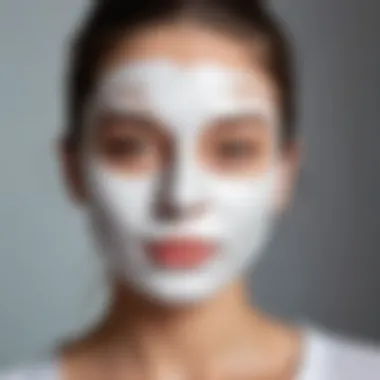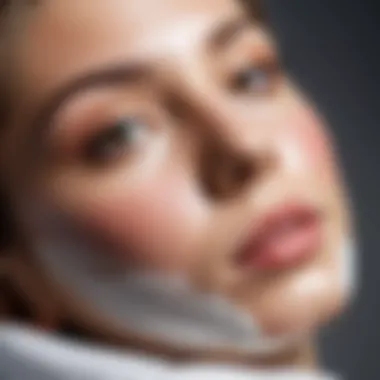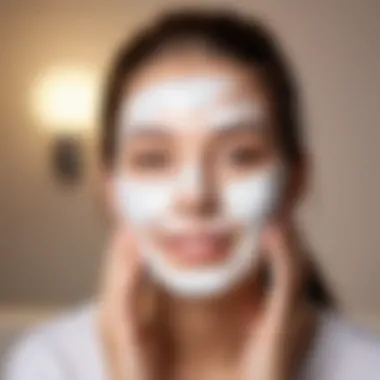Effective Facial Masks for Teenagers' Skincare


Intro
Teenagers face a unique set of challenges when it comes to their skin. Hormonal changes, increased oil production, and environmental stressors can lead to conditions like acne, dryness, and sensitivity. For this reason, the use of facial masks designed specifically for this age group can be highly beneficial. This guide will explore the different types of masks available, the ingredients that target common skin issues, and practical advice for integrating these products into a skincare routine.
Whether you are a teen or a parent looking for solutions, understanding the skin's needs during adolescence is crucial. The following sections will provide insight into current promotions, recommendations for choosing the right cosmetics, and more.
Understanding Teenage Skin
Understanding the unique nature of teenage skin is crucial for tailoring effective skincare solutions. Adolescents experience various changes in their bodies. One of the most prominent changes happens to their skin. It is essential to recognize these transformations, as they directly influence the types of facial masks and treatments that should be applied to address specific needs. Being aware of the characteristics of teenage skin and common issues faced can lead to better skincare choices and ultimately enhance skin health.
Characteristics of Teenage Skin
Teen skin mainly undergoes substantial changes driven by hormonal fluctuations. This age often sees increased oil production, leading to characteristics such as:
- Oiliness: The skin may become very oily due to androgens increasing sebum production.
- Larger Pores: The increased oiliness can also make pores appear larger, which can cause concern.
- Thinner Epidermis: Compared to adult skin, teenage skin is generally thinner and more delicate. This can make it more susceptible to damage.
- Higher Sensitivity: Despite oily skin, many adolescents may experience sensitivity or irritation due to various environmental factors or products.
These characteristics dictate how skin responds to treatments. Hence, selecting suitable products and masks is vital.
Common Skin Issues Faced by Teens
Skin issues during adolescence often stem from the hormonal changes occurring in the body. Some of the most common issues include:
- Acne: This is perhaps the most prevalent skin problem among teenagers. It often results in blackheads, whiteheads, and cystic acne on the face, back, or shoulders.
- Oily Skin: Teens may find their skin is consistently shiny or greasy, particularly around the T-zone.
- Dryness: Interestingly, some teens can suffer from dry patches despite having an oily complexion. This can result from harsh products or environmental conditions.
- Sensitivity and Allergies: Some teenagers may develop allergies to specific products or ingredients, leading to redness or irritation.
"Recognizing these issues early can help in managing them effectively."
Each of these conditions calls for different approaches to skincare. Understanding teenage skin in depth allows for better choices regarding facial masks, providing long-term benefits and improving skin health.
The Role of Facial Masks
Facial masks have become an essential part of skincare routines, especially for teenagers. The importance of these products lies not only in their effectiveness but also in their appeal to young individuals. As teenagers experience changes in their skin, faced with challenges such as oiliness and acne, facial masks serve multiple purposes. They can help to address specific skin concerns while also offering a moment of relaxation.
Incorporating masks in a skincare regimen is simple and provides immediate benefits, making them a popular choice for adolescents. A mask can act as a targeted treatment, allowing for deeper penetration of active ingredients than regular creams or lotions. This is crucial for teenagers who need effective solutions that fit their often busy lifestyles.
Moreover, the process of applying a facial mask can be therapeutic. It encourages young individuals to take time for self-care, which is important for mental well-being. A few quiet moments spent applying a mask can help relax and reduce the stress that often accompanies teenage life.
Benefits of Using Masks
Facial masks offer several advantages for teenagers:
- Deep Cleansing: Masks often contain ingredients designed to cleanse the pores deeply, reducing the risk of acne and breakouts.
- Hydration: Many masks are formulated with hydrating components, promoting moisture balance and preventing dryness.
- Targeted Treatment: Specific masks can target particular skin issues, such as oiliness or uneven skin tone.
- Ease of Use: Using a mask is straightforward. It requires minimal time and effort, appealing to teenagers who may not have extensive skincare routines.
These benefits make facial masks an attractive addition to the adolescent skincare arsenal.
Different Types of Facial Masks
Facial masks come in various formulations, each designed to cater to different skin types and concerns. Here, we will explore some of the most common types available today:
Sheet Masks
Sheet masks are one of the most popular facial mask types. They are made from materials like cotton or hydrogel and are pre-soaked in a serum.
- Key Characteristic: The sheet directly adheres to the skin, ensuring that the ingredients penetrate effectively.
- Benefits: This type of mask is beneficial for quick hydration and is easy to use. They can be found in numerous formulations, addressing various skin concerns like dryness or dullness.
- Unique Feature: The convenience of a sheet mask means it can be used almost anywhere, making it ideal for busy teenagers.
However, they may not always provide deep cleansing benefits compared to other mask types.


Clay Masks
Clay masks are known for their efficacy in drawing out impurities from the skin.
- Key Characteristic: They typically contain natural clays such as bentonite or kaolin, which can absorb excess oil and toxins.
- Benefits: These masks are particularly beneficial for oily or acne-prone skin. They help unclog pores and reduce inflammation.
- Unique Feature: The drying effect of clay masks can feel refreshing but may be too harsh for dry or sensitive skin types.
Peel-Off Masks
Peel-off masks offer a unique experience by allowing users to peel away the product after it has dried.
- Key Characteristic: These masks form a film over the skin, which effectively removes dead skin cells and impurities as it is peeled off.
- Benefits: They provide a satisfying sensation during removal and can leave the skin feeling smooth and refreshed.
- Unique Feature: The downside is that they can sometimes irritate sensitive skin or lead to small tears if not removed carefully.
Cream Masks
Cream masks have a rich, thick texture and are packed with moisturizing ingredients.
- Key Characteristic: These masks are usually left on for a period and rinsed off, delivering intense hydration.
- Benefits: They are ideal for dry or combination skin, offering nourishment and a boost of moisture.
- Unique Feature: While cream masks provide great hydration, they may not be suitable for very oily skin, which requires a lighter touch.
Understanding the role and features of these masks enables teenagers to make informed decisions about their skincare. Each type has specific advantages and limitations, depending on individual skin needs.
Choosing the Right Mask
Choosing the right mask is crucial for achieving healthy skin, especially for teenagers. During this stage of life, skin undergoes many changes and challenges due to hormonal fluctuations. These fluctuations often lead to issues like acne, oiliness, and dryness. A suitable mask can address these problems, providing targeted treatment and nourishment. Understanding how to choose the right mask can enhance a skincare routine, enabling teenagers to take control of their skin health.
Identifying Skin Type
To find the most effective mask, it is essential first to identify your skin type. Teenage skin can fall into several categories: oily, dry, combination, or sensitive. Each skin type has specific needs that different masks can address.
- Oily Skin: This skin type often produces excess sebum, leading to acne and shine. Clay masks can help absorb oil and reduce breakouts.
- Dry Skin: Characterized by flakiness and tightness, dry skin benefits from hydrating masks with moisturizing ingredients. Cream masks are often suitable.
- Combination Skin: A mix of oily and dry areas, combination skin requires a balance. A multi-masking approach, using different masks for varying areas, is effective.
- Sensitive Skin: Sensitive skin may react to harsh ingredients. Gentle masks with calming properties are ideal for avoiding irritation.
By knowing your skin type, you can select masks that provide the most benefit.
Key Ingredients for Teen Skin
When selecting masks, it is also vital to pay attention to the key ingredients. Certain components can have significant benefits tailored specifically for teenage skin needs. Popular ingredients include the following:
Salicylic Acid
Salicylic acid is a well-known acne treatment. It helps to unclog pores and reduces the formation of pimples. This ingredient is beneficial because it penetrates deeply into the skin, targeting oil and debris. The main characteristic of salicylic acid is its ability to exfoliate skin effectively. This could be both an advantage and disadvantage; while it helps with acne, it may irritate sensitive skin.
Benzoyl Peroxide
Benzoyl peroxide fights bacteria that cause acne. It works by reducing inflammation and providing a clearer complexion. A key feature of benzoyl peroxide is its antibacterial properties, which make it especially effective for active acne. However, it can be quite drying, so it is important to use it with care and follow up with moisturizers.
Hyaluronic Acid
Hyaluronic acid is a powerful hydrating agent. Its unique ability is to hold moisture, making it a popular choice for all skin types. This ingredient helps in maintaining skin moisture balance, making it excellent for dry and dehydrated skin. Advantages include providing lasting hydration without clogging pores, benefiting both oily and dry skin.
Vitamin
Vitamin C is known for its brightening effects. It helps to even out skin tone and improve overall radiance. This ingredient has antioxidant properties, protecting skin from damage. Another key characteristic is its ability to boost collagen production. However, some may find it irritating, especially those with sensitive skin.
Choosing a mask that includes these specific ingredients can help teenagers address their unique skin challenges effectively.
Applying Facial Masks


Applying facial masks is an integral part of skincare for teenagers. It allows them to address specific skin concerns while establishing a routine that promotes self-care and awareness of their own skin needs. Different types of masks serve various functions, from hydrating to exfoliating, which can aid in coping with issues like acne or dryness often experienced during adolescence.
Preparation Steps
Before applying a facial mask, it’s essential to prepare both the skin and the environment. This preparation enhances the efficacy of the mask. These are some important steps to keep in mind:
- Cleanse the Face: Start with a gentle cleanser suitable for teenage skin. This removes dirt, oil, and makeup, ensuring that the mask can penetrate the skin effectively.
- Exfoliate (Optional): If the skin type allows, a gentle scrub can help remove dead skin cells. This step is optional but beneficial before applying a mask, as it allows better absorption of the ingredients.
- Pat Dry: Use a clean towel to dry the face, ensuring the skin is slightly damp. This can help some masks to adhere better.
- Gather Materials: Have the mask ready and any tools required for application, such as brushes or spatulas.
Application Techniques
The technique used in applying masks can greatly influence their effectiveness. Here are some strategies:
- Use Clean Hands or Tools: Ensure everything that comes in contact with your face is clean to avoid introducing bacteria.
- Even Layer: Apply the mask in an even layer, avoiding the eyes and lips. Start from the center of the face and move outward.
- Gentle Movements: For cream-based or gel masks, use your fingertips or a brush to spread evenly. If using a peel-off mask, ensure a thick enough layer for proper removal later on.
- Follow Timing Instructions: Adhere to the time recommended on the product label. Leaving the mask on longer than suggested may irritate the skin.
Post-Mask Care
After removing the mask, the post-care routine is crucial to maintain skin health. Consider the following:
- Rinse with Warm Water: Remove the mask according to its type. For clay masks, rinse thoroughly with warm water, while peel-off masks should be carefully peeled away.
- Toner Application: Use a gentle toner to help restore the skin's pH balance. This step can also help tighten pores.
- Moisturize: Applying a suitable moisturizer is essential after a mask. This helps to lock in hydration and prevent the skin from drying out.
- Observe Skin Reaction: Take note of how the skin feels post-application. If irritation or redness occurs, consider switching to milder masks in future applications.
Always listen to your skin. What works for one person may not work for another.
By incorporating these steps into the facial masking routine, teenagers can effectively address their skin concerns while fostering a positive skincare habit.
Incorporating Masks into a Skincare Routine
Incorporating facial masks into a skincare routine is essential for teenagers. This age group often faces unique challenges like hormonal changes that impact their skin. Regular use of masks can help manage these issues effectively. Masks not only serve as treatment for specific skin conditions but also boost overall skin health. The following sections will detail how to use masks properly and the benefits they provide.
Frequency of Use
Determining how often to use facial masks is crucial. It is generally recommended to use masks 1 to 3 times a week, depending on skin type and specific concerns. For instance, young people with oily or acne-prone skin may benefit from more frequent treatments using clay masks. These types help absorb excess oil and reduce breakouts. On the other hand, those with dry skin should opt for hydrating cream masks, using them once a week to avoid overwhelming their skin.
Here are some factors to consider when establishing a frequency:
- Skin Type: Oily skin might require more frequent masking.
- Product Type: Some ingredients, like salicylic acid, may work better with regular application.
- Environmental Factors: Changes in weather or exposure to pollution can affect skin needs.
Complementary Skincare Products
Using facial masks effectively often means pairing them with compatible skincare products. A well-rounded routine can enhance the benefits of masks.
- Cleansers: A gentle cleanser should be used before applying any mask. This prepares the skin by removing dirt and impurities.
- Toners: After cleansing, toners can help balance the skin’s pH. They also prepare the skin for better absorption of the mask’s ingredients.
- Moisturizers: Following mask application, a light moisturizer should be applied to hydrate the skin. This helps sealing in the mask's benefits.
Moreover, products containing complementary active ingredients, such as Vitamin C or hyaluronic acid, can amplify the effects. For example, using a Vitamin C serum can further brighten the skin after using a brightening mask.
"Creating a routine with the right products will help maximize the benefits of skincare treatments."
Overall, understanding how to incorporate masks into a skincare routine can significantly improve skin health for teenagers. Consistency and careful selection of products contribute to achieving the best results.
Homemade Mask Alternatives
Homemade mask alternatives provide compelling options for teenagers seeking to care for their skin. These masks can be customized based on individual skin needs and preferences. The appeal lies not only in their cost-effectiveness but also in the ability to control the quality of ingredients used. This can lead to better results and generally fewer adverse reactions than some commercial products.
Simple Recipes for Teenagers
Creating homemade masks can be straightforward. Here are some easy recipes which cater to various skin issues:


- Honey and Oatmeal Mask:
- Avocado and Yogurt Mask:
- Banana and Lemon Mask:
- Green Tea and Aloe Vera Mask:
- Combine one tablespoon of honey with two tablespoons of ground oatmeal.
- Apply to face for 15 minutes, then rinse with warm water.
- This mask helps with dryness and provides gentle exfoliation.
- Mash half an avocado and mix it with one tablespoon of plain yogurt.
- Leave on for 20 minutes for hydration and nourishment.
- Mash one ripe banana and add a few drops of fresh lemon juice.
- Apply for 10-15 minutes. This mask is great for oily skin and can help address blemishes.
- Brew green tea, let it cool, and mix with two tablespoons of aloe vera gel.
- Use this mix for a calming effect on irritated skin.
These simple recipes allow teenage users to harness the power of natural ingredients effectively.
Benefits of Natural Ingredients
Using natural ingredients in homemade masks has multiple benefits.
1. Fewer Chemicals: Traditional formulations can contain a number of synthetic ingredients that some individuals may find irritating. Natural ingredients, such as honey, yogurt, and avocado, can reduce the likelihood of skin sensitivities.
2. Rich Nutrients: Many plant-based components are packed with vitamins and minerals essential for skin health. For example, honey has antioxidant properties, while yogurt contains lactic acid, which can help with exfoliation.
3. Customization: Teens can personalize their skincare routine. Different skin types benefit from various components. It is easier to adapt a mask to individual needs than relying on one-size-fits-all products.
4. Cost-Effectiveness: Homemade masks are usually more cost-effective than most commercial products. The ingredients can often be found at home or purchased inexpensively at stores.
Potential Risks and Considerations
When considering the use of facial masks for teenagers, it becomes essential to address the potential risks and several considerations involved. This demographic often experiences unique challenges related to their skin. Hence, understanding these risks helps in making informed choices.
Skin Sensitivities and Allergies
Teenagers may have skin that is sensitive or prone to allergies, making it crucial to choose facial masks carefully. Sensitive skin can react unpredictably to certain ingredients. Common symptoms include redness, itching, or a burning sensation.
It is imperative to conduct a patch test before applying any mask to the entire face. This typically involves applying a small amount of the product on the inner arm or behind the ear and waiting for 24 hours. If no reaction occurs, it is likely safe for use.
Additionally, some teenagers might have allergies to natural ingredients like nuts or fragrances often added to masks. Reading the ingredient list closely enables informed decisions. Avoiding masks with harsh chemicals, particularly sulfates and parabens, also plays a role in ensuring skin safety.
Expiry Dates and Storage
Another significant aspect to consider is the expiry date and proper storage of facial masks. Many masks contain active ingredients that can lose effectiveness over time.
Expired products can lead to adverse reactions on the skin, such as irritation or breakouts. Therefore, always check the packaging for expiration dates. It is wise to discard any masks that are past their expiration.
Storage conditions matter as well. Masks should generally be kept in a cool, dry place. Many require refrigeration to maintain their integrity, especially those containing natural ingredients. Heat and humidity can diminish the mask's efficacy or cause it to spoil more quickly.
Culmination
In this article, we have explored significant aspects of facial masks tailored specifically for teenagers. Understanding the unique characteristics of teenage skin is vital. Adolescents often face common skin issues such as acne, oiliness, and dryness. Using the right masks can address these concerns effectively. Facial masks not only serve as a treatment option but also as a preventive measure to maintain skin health.
One of the main benefits of facial masks is their ability to deliver concentrated ingredients directly to the skin. Masks containing salicylic acid help combat acne, while hyaluronic acid provides essential hydration. Understanding which ingredients work best is crucial in selecting the right products.
It is also important to note that applying masks correctly and incorporating them into a skincare routine can enhance their effectiveness. Proper post-mask care, such as using moisturizers afterward, cannot be overlooked.
We have emphasized the importance of being mindful of allergies and skin sensitivities, especially for teens. Ensuring that the products used are safe and free of irritants is paramount. This promotes a healthy skincare journey.
By summing up the outlined points, we reinforce that knowledge is critical in making informed decisions regarding skincare.
Recap of Key Points
- Teenage skin has unique characteristics that require special attention.
- Common issues include acne, oiliness, and dryness.
- Different types of masks provide various benefits tailored for these issues.
- Key ingredients such as salicylic acid and hyaluronic acid are essential for treatment.
- Proper application techniques and post-mask care enhance effectiveness.
- Awareness of skin sensitivities protects against negative reactions.
Encouragement for Healthy Skin Choices
Establishing a solid skincare routine is vital during teenage years. Choices made now can impact skin health in the long term. Teens should be encouraged to experiment with different masks. This allows for discovering what works best for individual skin types. Emphasizing the significance of natural ingredients in homemade masks can also be beneficial.
Ultimately, fostering a positive relationship with skincare helps in building confidence. By making informed choices, teens can navigate their skincare journey with ease and achieve healthier, radiant skin.















